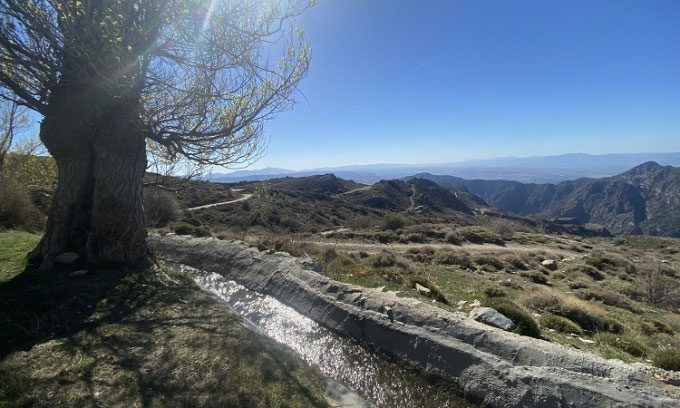The ancient network of irrigation canals, stretching over 24,000 km, channels water from the mountains down to arable land below, enabling farmers in drought-stricken areas to replant fruit trees.
A more than 24,000 km long canal system running through the mountainous regions of Spain is being restored as a cost-effective measure to lead water for irrigation during periods of intense heat and increasing drought. This irrigation network, built by the Moors, transports melted snow from the mountains and distributes it to the land below, according to Business Insider.

An irrigation canal in Andalusia. (Photo: The World).
Experts believe that this ancient solution will help convey water across the arid regions of Spain and sustain agricultural practices. The only issue is that very few people are aware of how the canal system operates. As Spain gradually shifts towards an agricultural model focused on water reservoirs and many people in rural areas move to cities, the number of those knowledgeable about the irrigation system is dwindling. Only a few know how to restore the canals. Historians and conservators are collaborating to restore the canal system and accumulate the necessary knowledge on how to operate them.
The irrigation canals were built by the Moors between the 8th and 10th centuries in the Al-Andalus region of the Iberian Peninsula. This canal system is an innovative solution for transporting water, transforming the entire mountainous landscape. The Andalusia region of Spain has a Mediterranean climate with long summers and cold, dry winters. When the Moors introduced the canals to Spain and used them to transport water more efficiently, they changed the landscape. Today, the provinces of Granada and Almeria in Andalusia are leading agricultural areas in Spain.
The canals draw water from melting snow and rain on the hills. By channeling the water along a path, the melted snow can slow down and provide for the land along the way. Without irrigation canals, the snowmelt would flow into dry rivers and lakes in the winter, resulting in a shorter water cycle.
The canal system also replenishes the aquifer and feeds into rivers and streams below the mountains. As water flows through the canals, it moistens the soil and is stored in the bedrock until needed. This water not only irrigates crops and softens the soil but even fills fountains in the Andalusia region.
However, in recent decades, the irrigation canals have been neglected in favor of industrial agriculture. In the 1960s, Spain began prioritizing water reservoirs for farming. Rural populations migrated to cities, resulting in a 28% decline in rural population over the past 50 years, along with about 15-20% of the irrigation canals being abandoned. Over time, debris, broken bricks, grasses, and various other plants have taken over the canal beds. Temperatures have also risen in Spain, damaging agricultural land. The increase in temperature, combined with industrial farming, has rendered many areas barren as water is diverted to more profitable large-scale farms.
To combat severe drought, farmers, volunteers, and researchers in Spain are collaborating to revive the irrigation system. Equipped with gardening tools and spades, volunteer groups are contributing to bringing water back to drought-affected areas. Thanks to the restored canals, farmers can continue to grow fruit trees.


















































